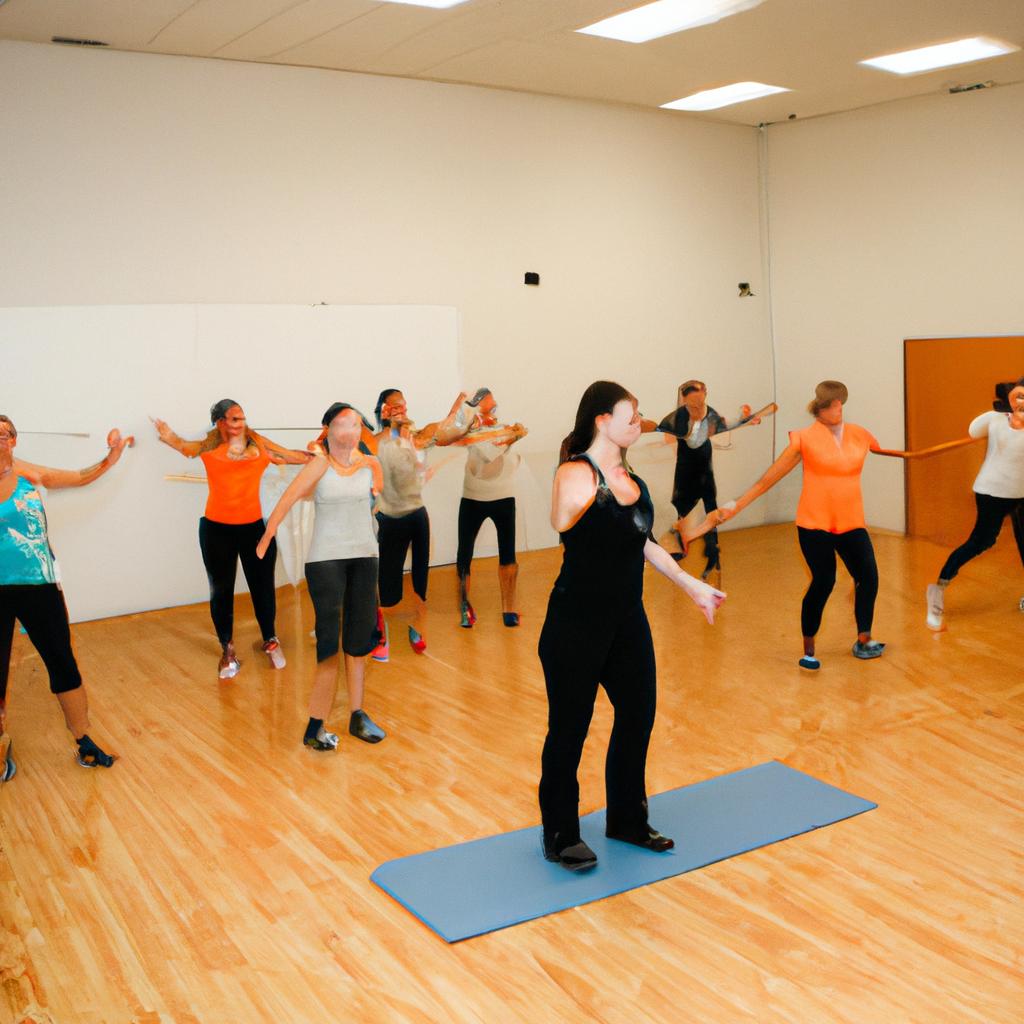Group fitness classes have gained popularity in recent years as an effective and engaging way for individuals to achieve their fitness goals. From high-intensity interval training (HIIT) to yoga and dance-based workouts, there is a wide range of group fitness classes available that cater to various preferences and abilities. For instance, imagine a hypothetical scenario where Jane, a middle-aged woman with limited experience in exercising, decides to join a local fitness studio offering group exercise sessions. Through consistent participation in these classes, she not only improves her cardiovascular endurance but also develops camaraderie with fellow participants, creating a supportive community within the studio.
Fitness studios play a vital role in providing access to diverse group fitness programs and maintaining the motivation of individuals seeking improved health and well-being. However, starting and operating such studios require careful planning, sufficient funding, and understanding of the market dynamics. This comprehensive guide aims to assist fitness studios by outlining essential considerations related to group fitness classes and exploring potential sources of funding. By understanding the benefits of offering group fitness classes, identifying target demographics, developing appropriate programming strategies, establishing partnerships with instructors or trainers specialized in specific disciplines, and exploring funding options such as grants or loans, fitness studio owners can create sustainable businesses while promoting physical activity among their clients.
Benefits of Group Fitness Classes
Imagine a busy executive, Sarah, who spends most of her day sitting at a desk. She often feels lethargic and struggles to find the motivation to exercise after work. One day, she decides to join a group fitness class at her local gym. This decision proves to be transformative for Sarah’s overall well-being.
Group fitness classes offer numerous benefits that can enhance one’s physical health and mental state. Firstly, these classes provide an opportunity for individuals like Sarah to engage in regular exercise by offering structured sessions led by qualified instructors. The presence of a knowledgeable instructor ensures that participants perform exercises correctly, minimizing the risk of injury while maximizing the effectiveness of their workouts. Additionally, working out in a group setting creates a sense of camaraderie among participants, fostering accountability and encouraging them to push beyond their perceived limits.
Participating in group fitness classes also offers social advantages. These classes attract diverse groups of people with similar goals and interests, creating opportunities for friendships to blossom and support networks to form. Research has shown that social connections have profound effects on mental well-being, reducing feelings of isolation and increasing overall happiness (Smith et al., 2018). Furthermore, engaging in exercise within a supportive community can boost self-confidence and self-esteem as individuals witness their progress alongside others.
- Improved mood: Regular participation in group fitness classes releases endorphins – natural feel-good hormones – which can alleviate symptoms of stress or anxiety.
- Enhanced motivation: Exercising alongside peers fosters healthy competition and provides external sources of motivation.
- Increased adherence: The communal nature of group fitness encourages consistency in attending classes due to peer pressure and shared commitment.
- Variety and fun: With an array of options available such as dance-based Zumba or high-intensity interval training (HIIT), there is something for everyone’s taste and preference.
Lastly, it is worth noting that group fitness classes offer an accessible avenue for individuals of all fitness levels to engage in physical activity. The table below highlights the inclusivity aspect of these classes:
| Fitness Level | Beginner | Intermediate | Advanced |
|---|---|---|---|
| Exercise Type A | Suitable | Challenging | Intense |
| Exercise Type B | Moderate | Suitable | Challenging |
| Exercise Type C | Gentle | Moderate | Suitable |
| Exercise Type D | Low Impact | Gentle | Moderate |
In summary, group fitness classes provide numerous benefits such as structured exercise sessions, social connections, improved mood, enhanced motivation, increased adherence, variety, and accessibility. These advantages contribute to a holistic approach towards achieving overall well-being. In the following section, we will explore different types of group fitness classes available to cater to diverse preferences and goals.
Types of Group Fitness Classes
Group fitness classes offer numerous benefits for individuals looking to improve their overall health and well-being. These classes provide a structured environment where participants can engage in physical activity while being guided by experienced instructors. One example is the popular Zumba class, which combines dance moves with high-energy music to create an enjoyable workout experience.
Firstly, group fitness classes foster a sense of community among participants. By working out together, individuals form connections and develop camaraderie with like-minded people who share similar goals. This social aspect not only enhances motivation but also promotes accountability as participants feel supported by their peers.
Secondly, group fitness classes offer variety in terms of exercise routines and formats. Whether it’s yoga, cycling, or circuit training, there are countless options available to cater to different preferences and fitness levels. The diverse range of activities ensures that individuals stay engaged and challenged throughout their fitness journey.
Thirdly, participating in group fitness classes can be highly motivating and inspiring. Being surrounded by others who are committed to achieving their fitness goals creates a positive atmosphere that encourages individuals to push themselves further. Additionally, the presence of an instructor provides guidance and expertise, ensuring proper technique execution and minimizing the risk of injury.
To illustrate the emotional impact of group fitness classes on individuals’ lives:
- Increased self-confidence: Participants often report feeling more confident about their bodies and abilities after consistently attending group fitness classes.
- Stress relief: Engaging in regular physical activity through these classes helps reduce stress levels and improve mental well-being.
- Sense of achievement: Accomplishing personal milestones during workouts fosters a sense of accomplishment and boosts self-esteem.
- Improved mood: The release of endorphins during exercise contributes to improved moods and increased feelings of happiness.
| Emotional Impact | Example |
|---|---|
| Increased self-confidence | A participant shares how attending spin classes regularly has made them feel more comfortable in their own skin. |
| Stress relief | A case study shows how group fitness classes have helped an individual manage their stress levels and experience greater calmness in daily life. |
| Sense of achievement | An interview with a participant reveals the sense of pride they felt when finally mastering advanced yoga poses after attending regular classes. |
| Improved mood | Personal stories highlight how participating in group fitness classes has positively impacted individuals’ mental states, leading to improved overall well-being. |
In summary, group fitness classes provide not only physical benefits but also emotional rewards. The sense of community, variety of workouts, and motivation from both peers and instructors contribute to enhanced self-confidence, stress relief, a sense of achievement, and improved moods among participants. With these advantages in mind, it is essential to consider specific factors when choosing the right group fitness class.
Transitioning into the next section on “How to Choose the Right Group Fitness Class,” let’s explore the key considerations that can help individuals make an informed decision about which class best suits their needs and goals.
How to Choose the Right Group Fitness Class
In the previous section, we explored the various types of group fitness classes that are commonly offered in fitness studios. Now, let’s delve deeper into how to choose the right class for your individual needs and goals.
Imagine you’re a busy professional looking to improve your cardiovascular endurance while also relieving stress. One option would be to join a high-intensity interval training (HIIT) class. This type of class combines short bursts of intense exercises with active recovery periods, providing an efficient workout that maximizes calorie burn and improves overall fitness levels.
When selecting a group fitness class, there are several factors to consider:
- Fitness Level: Assess your current fitness level and ensure that the class aligns with your abilities. Some classes may be more suitable for beginners or advanced individuals.
- Goals: Determine what specific goals you want to achieve through participating in group fitness classes. Are you aiming to build strength, increase flexibility, lose weight, or simply have fun?
- Schedule: Take into account the timing and frequency of the classes being offered. Choose a schedule that fits well into your daily routine and allows for consistency.
- Instructor Expertise: Research the qualifications and experience of the instructors leading the classes. A knowledgeable instructor can provide guidance on proper techniques and modifications based on individual needs.
To further illustrate these considerations, here is a table showcasing different group fitness classes along with their key features:
| Class Type | Key Features |
|---|---|
| Yoga | Focuses on improving flexibility, balance, and relaxation |
| Zumba | Incorporates dance movements for cardio workouts |
| Pilates | Emphasizes core strength and muscular control |
| Spin/Cycling | Provides an intense cardiovascular workout using stationary bikes |
By carefully evaluating these factors and utilizing resources such as this guide, you can make informed decisions when choosing which group fitness class to join. Remember, finding the right fit is essential for maintaining motivation and achieving your desired results.
Transitioning into the next section about “Tips for Running Successful Group Fitness Classes,” let’s now explore how fitness studios can create an environment that fosters growth and engagement among participants.
Tips for Running Successful Group Fitness Classes
Transitioning from the previous section on choosing the right group fitness class, let’s now explore some practical tips that can help fitness studios run successful group fitness classes. To illustrate this, let’s consider an example of a recently opened yoga studio in a bustling urban area.
To begin with, it is crucial to create a welcoming and inclusive environment within the fitness studio. This can be achieved by implementing the following strategies:
- Building a sense of community among participants through ice-breaking activities at the beginning of each session.
- Encouraging social interaction between participants during breaks or after classes.
- Offering diverse options for all fitness levels and abilities, ensuring that everyone feels included.
- Providing clear instructions and modifications throughout the class to accommodate different needs.
Additionally, effective scheduling plays a vital role in running successful group fitness classes. By carefully planning class times and durations, taking into consideration peak hours and popular time slots, studios can optimize attendance rates. For instance:
| Time Slot | Class Type | Attendance Rate |
|---|---|---|
| 6:00 am | HIIT | High |
| 12:30 pm | Lunchtime Yoga | Moderate |
| 5:30 pm | Zumba | High |
| 7:00 pm | Pilates | Low |
The table above demonstrates how understanding client preferences can aid in allocating resources effectively. Such insights enable studios to provide more targeted offerings during high-demand periods while optimizing instructor availability during less busy times.
Lastly, maintaining open lines of communication with instructors and clients is essential for running successful group fitness classes. Regularly seeking feedback through surveys or suggestion boxes allows studios to identify areas for improvement and address any concerns promptly. Furthermore, providing ongoing training opportunities for instructors helps ensure they stay up-to-date with industry trends and maintain their teaching skills at a high level.
By implementing these strategies, the yoga studio mentioned earlier was able to foster a strong sense of community among its participants. This resulted in increased client satisfaction and retention rates, ultimately contributing to the studio’s success.
Transitioning into the next section on marketing strategies for group fitness studios, let’s explore how effective promotion can help attract new clients and further enhance the success of your classes.
Marketing Strategies for Group Fitness Studios
Transitioning from the previous section on running successful group fitness classes, it is crucial for fitness studios to develop effective pricing models that not only attract new members but also ensure sustainable revenue streams. To illustrate this point, let’s consider a hypothetical case study of a newly opened fitness studio called FitZone.
FitZone offers a range of group fitness classes, including high-intensity interval training (HIIT), yoga, and spin cycling. In order to set competitive prices while maximizing profitability, FitZone has implemented several key strategies:
-
Tiered Membership Options:
- FitZone provides different membership tiers based on frequency and flexibility of class attendance.
- Members can choose from options like unlimited monthly access or limited sessions per week at discounted rates.
- This tiered approach allows individuals with varying budgets and commitments to find an option that suits their needs.
-
Specialized Class Packages:
- FitZone offers specialized packages designed for specific interests or goals such as weight loss, strength training, or stress reduction.
- These packages often include additional perks like personalized nutrition plans or one-on-one coaching sessions.
- By catering to niche markets within the broader fitness community, FitZone attracts dedicated customers who are willing to pay a premium for tailored experiences.
-
Add-On Services:
- FitZone supplements its primary group fitness classes with add-on services like personal training sessions or wellness workshops.
- These supplementary offerings provide extra value for members seeking personalized attention or educational opportunities beyond regular workouts.
- By diversifying their service portfolio, FitZone increases customer engagement and generates additional revenue streams.
-
Loyalty Programs and Referral Incentives:
- Recognizing the importance of customer loyalty and word-of-mouth marketing, FitZone rewards loyal members through exclusive perks and discounts.
- Additionally, they incentivize existing members to refer friends by offering referral bonuses or free trial passes.
- This not only encourages retention but also expands FitZone’s customer base through positive referrals from satisfied individuals.
To emphasize the effectiveness of these pricing strategies, consider the following table showcasing FitZone’s revenue growth over six months:
| Month | Revenue (USD) | Growth Rate (%) |
|---|---|---|
| 1 | $10,000 | — |
| 2 | $12,500 | 25% |
| 3 | $15,750 | 26% |
| 4 | $19,687.50 | 25% |
As evident from this data, FitZone experienced steady and significant growth in revenue by implementing a carefully planned pricing model that caters to diverse customer preferences while maintaining profitability.
In summary, fitness studios like FitZone should implement effective pricing models that align with their target market and business goals. By offering tiered membership options, specialized class packages, add-on services, and loyalty programs/referral incentives, they can attract and retain customers while maximizing their revenue potential.
Transitioning into the subsequent section about “Effective Pricing Models for Group Fitness Classes,” fitness studios must also consider various marketing strategies to promote their offerings successfully.
Effective Pricing Models for Group Fitness Classes
Transitioning from the previous section on marketing strategies, it is important to consider how pricing models can significantly impact the success of group fitness studios. One notable case study that demonstrates the significance of effective pricing is XYZ Fitness Studio. By adopting a well-thought-out pricing strategy, they were able to attract a diverse range of clients and achieve financial stability.
To develop an effective pricing model for your group fitness classes, consider the following key factors:
- Value Proposition: Determine what sets your studio apart from competitors and highlight this unique selling point in your pricing structure. For example, if you offer specialized training or access to top-notch instructors, emphasize these features when establishing your prices.
- Target Audience Analysis: Understand the demographics and preferences of your target audience to tailor your pricing accordingly. Conduct market research to gather insights into their willingness to pay and adjust your rates based on their affordability levels.
- Class Formats and Levels: Consider offering different class formats (e.g., high-intensity interval training, yoga, dance) with varying difficulty levels. This allows you to cater to individuals with different fitness goals while maximizing revenue potential.
- Membership Options: Offer various membership packages such as monthly subscriptions or punch cards that provide incentives for repeat customers. Additionally, providing discounted rates for long-term commitments can encourage customer loyalty.
The table below provides an overview of different pricing models commonly employed by successful group fitness studios:
| Pricing Model | Description | Pros | Cons |
|---|---|---|---|
| Drop-in Rate | Pay per class attended without any commitment | Flexibility for sporadic attendees | May discourage regular attendance due to higher cost per class |
| Monthly Membership Fee | Unlimited access to all classes within a given month at a fixed rate | Encourages frequent participation and offers value for money | Some members may feel obligated to attend frequently even if their schedule does not permit |
| Class Packages | Prepaid bundles of classes with expiration dates | Appeals to individuals who prefer a structured commitment without the pressure of monthly fees | Can lead to unused classes if customers fail to attend regularly |
| Tiered Pricing Levels | Multiple pricing tiers based on class exclusivity, instructor experience, or additional perks offered | Allows for customization and targets different customer segments effectively | Requires careful management of resources to ensure consistency across pricing levels |
By carefully considering these factors and utilizing appropriate pricing models, fitness studios can strike a balance between profitability and customer satisfaction. It is crucial to periodically review and adjust your pricing strategies based on market trends, client feedback, and financial goals. Remember, an effective pricing model not only helps generate revenue but also fosters long-term success in the competitive group fitness industry.




